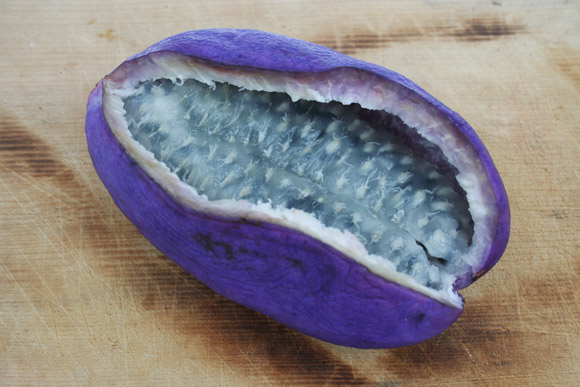
Cultivated Akebi, photo by Kyoto Foodie
Any plant with “chocolate” in the name is sure to get attention. And when it’s also called an invasive species then even more so.
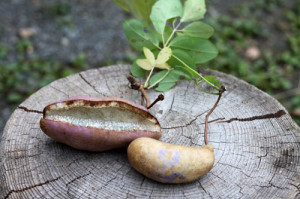
Wild Chocolate Vine Fruit, photo by Tsure Zure Gusa
Oddly the Chocolate Vine reminds me of the Camphor Tree. They are not even remotely related but when you read about the Camphor Tree it seems to have arrived everywhere from China in 1875, not 1874, not 1880, not 1896. Always 1875. Whether New York, San Francisco or Tampa, they all got a Camphor Tree in 1875. With the Chocolate Vine it’s 1845… everywhere…. London to New York… 1845… only in Asia in 1844 and everywhere else in 1845. While not impossible perhaps not probable. What we do know for certain is that it arrived in Britain from China in 1845. We know that because the Chocolate Vine was brought out of China by the most famous plant smuggler and secret agent of his day, a Scotsman called Robert Fortune.
Once Fortune got the Chocolate Vine to England it came to the United States, if not in 1845 then soon thereafter. Call that a training theft before the big heist because he then went back for all the tea in China, literally. It was Fortune who three years later single-handily smuggle tea plants and industry knowledge out of China — where the British had little influence — to India where they did. He did so by disguising himself as a Chinese peasant though he did not speak Chinese and knew nothing of botany. He also broke an agreement not to travel for more than a day’s journey from port cities. For the next 150 years India led the world in tea production. Only recently has China become the main producer of tea again. Fortune is why the British drink tea.
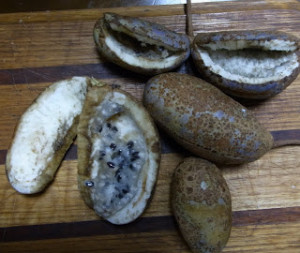
Wild “Akebi”ready for cooking, or eating raw. Photo by Ponkanchan
Most references are quick to say the Chocolate Vine produces an edible fruit but it doesn’t fruit often and isn’t interesting, as if to discredit any possible benefit this “invasive” might have. However, there is more to it. The mild, viscous pulp of the soft fruit is eaten raw with lemons juice or pureed and made into a cream or a drink. It has a slight coconut milk flavor. Young shoots are used in salads or for salt pickling. The bitter skin of the fruit is fried and eaten and the leaves used as a tea substitute. The empty pod is stuffed and deep fried. The fruit is also used to make wine. The seed oil is was used to make soap and as a vegetable oil. In fact the seeds are about 33% oil but on the bitter side. Most folks spit them out particularly the Japanese who view seeds in any food unappealing. The seeds, however, are edible. A relative, Akebia trifoliata, Mitsuba Akebi, is used in a similar way. Both are high in protein. A 70-gram serving of the fruit has 57 calories and 46mg of vitamin C. Akebi is also now cultivated as a crop in Japan providing a steady seasonal market.
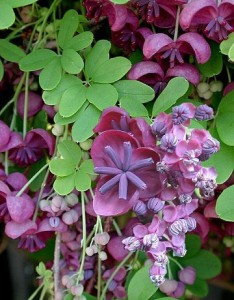
Chocolate Vine in Blossom, photo by valentine.gr
Botanically the Chocolate Vine is Akebia quinata (a-KEE-bee-uh kwi-NAY-tuh.) Akebia is the Dead Latin version of the native Japanese name, Akebi (AH-ke-bee.) Quinata means having five parts, in reference to the five-leaflet palmate leaves. It is in the quixotic Lardizabalaceae family, name for Miguel de Lardizabel y Uribem, a Spanish naturalist in the 1700s. The vine was scientifically classified by Brussels-born botanist Joseph Decaisne in the 1800s who used the Japanese name. Decaisne had gained some reputation in France for studying new plants from China. He was the natural choice to classify it. Fortune had called the species Rajania. Naive to Japan, Central China, and Korea it is found in Connecticut, District of Columbia, Georgia, Illinois, Indiana, Kentucky, Louisiana, Maryland, Massachusetts, Michigan, Missouri, North Carolina, New Jersey, New York, Ohio, Oregon, Pennsylvania, Rhode Island, South Carolina, Texas, Virginia, Washington state near Seattle. It is also invasive in New Zealand, southwest England, and threatening to become invasive in other parts of Europe.
Sometimes in Japan the purple-ripe version is called Murasaki Akebi, whereas a brown version is “Ishi Akebi” (stone akebi.) In Japanese the fruit is 通草, or 木通, though in native Hiragana it is あけび… (I lived in Japan a few years and would like to thank Avi Landau’s Tsukublog and Japan Homesteading.)
The Akebi is closely related to the Mube, or Stauntonia (Stauntonia hexaphylla) which also has an edible fruit except it does not split open when ripe. It is sometimes planted as an ornamental.
Green Deane’s Itemized Plant Profile: The Chocolate Vine
IDENTIFICATION: Akebia quinata , a twining vine green when young, turning brown with age, lenticels noticeable. Leaves palmately compound with up to five 1.5 to 3 inch long, oval leaflets, is deciduous to semi-evergreen to evergreen depending on the climate it is growing in. Flowers are fragrant and monoecious with both male ( 1/4 inch) and female blossoms (1 inch) on the same raceme, the aroma ranges from lightly chocolate to lilac to vanilla to allspice. Noses can’t agree. The dangling flowers produce fruit that resemble little egg plants. Seed pods purplish with white pulp, black seeds. Vine can grow to 40 feet long. There are five cultivated varieties. Alba: Vigorous with white flowers, Leucantha: White flowers, similar to Alba, Purple Bouquet: Most common in trade, desirable for its compact size, growing about half the height of other varieties, Rosea: Flowers are more pale than the unnamed species, helping them to stand out against the dark foliage, and Variegata: Showy splashes of white on foliage make an attractive backdrop for pink blossoms. Besides having a chocolate aroma (to some) the blossoms sometimes are also dusky in color hence a second reason for calling it the Chocolate Vine.
TIME OF YEAR: Flowers in mid-spring. Fruits September to October. Like apples in the northern United States ripening Akebi tell the Japanese fall has arrived.
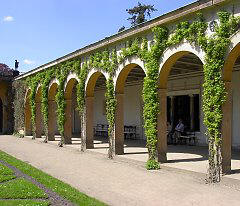
Akebi is often used for its vigorous growth, as here in Potsdam / Brandenburg, Castle Park Sanssouci, photo by Fassaden Grun
ENVIRONMENT: Grows easily in most soils, does best in well-drained sandy loam with regular moisture and full sun. Can form dense mats as an understory species. It can also climb and kill small trees and shrubs. In its native range it is found along forest edges, streams banks and mountain slopes. For best fruit production there should be more than one vine for good cross-pollination. Hand pollinating increases fruit production. They do not self-pollinate. Propagate by using tip layering or softwood stem cutting. From seed the plant takes five years to mature.
METHOD OF PREPARATION: When ripe the wild pods will look like purplish-blueish little mango-shaped eggplants that have been slit open. Pulp of the fruit eaten raw or made into a drink or wine, young shoots in salads or pickled with salt, bitter skin fried (often with miso) or cooked with sugar, leaves used as a tea substitute. The fruit dehydrates well whole. Pulp-less pods can be stuffed and deep fried. You can eat the seeds or spit them out. Better, plant them for edible shoots. Seeds of A. quinata usually germinate in one to three months at 59°F or 15°C. Medicinally sliced inner vine is used to make a diuretic. Young vines are used to make baskets.
Akebi Pod Miso Itame あけび みそ炒め by Kyoto Foodie
Ingredients
- 1 akebi pod (inner fruit removed)
- 2 tablespoons oil (sesame oil is nice)
- 1-2 teaspoon miso paste (same as for miso soup)
- 1 teaspoon sugar
- 1 teaspoon shoyu (Japanese soy sauce)
- 2 tablespoons of ryorishu (cooking sake or sake)
- shiso leaf (fresh green shiso leaf) optional
Use at least two teaspoons of Kansai-style sweet miso paste which is light in color. Tohoku style miso is red and saltier and you might want to go easy on the amount if you are using that style of miso. Adjust amount based on the kind of miso you are using and of course your taste.
Preparation
If you would like to remove some of the bitterness you can soak the pod halves or slices in warm water for 30 to 60 minutes. Pat dry before sauteing.
Mix all the liquid ingredients together in a bowl, dissolving the miso paste and sugar.
Heat a fry pan and add several tablespoons of oil. Once hot, add sliced akebi pod and saute covered until akebi softens, this should take about 2 minutes.
Pour in liquid ingredients, reduce heat and simmer down until little liquid remains. This should take 1 to 2 minutes. Due to the high sugar content, the mixture will quickly burn – don’t allow that to happen. Once the liquid has been reduced, serve on a plate and garnish with chopped shiso leaf.


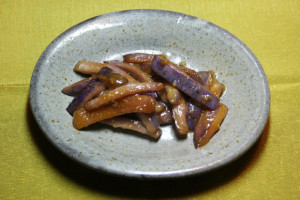


Where can I get some AKEBI seeds?
We have akebia vines here on Putney Farm. Ours are akebia Quinana. I am looking for akebia trifolata, and will trade or sell.
You can get these from the Houston Arboretum, in North Harris county, Houston, Texas.
You can get a. trifolata seed on ebay.
The Akebia plant roots easily by runners and is easily transplanted by severing and digging the rooted runners. We use the leaves as tea and also grinding to a powder and sprinkling into meals, as it is said to be anti tumor and anti cancer. The vines turn semi woody and are very good material for basket weaving. We have also found it to be good chicken fodder, as the leaves are semi evergreen here in Upstate SC zones 7 and 8A. I find the tendrils to be bitter when eaten raw, but have not experimented with cooking them. They have beautiful little blooms and are delightful climbers to add summer shade. They don’t seem to mind severe pruning, so can be cut back whenever needed, which is annually, to keep it in check. makes a great fence cover and I am sure this plant has many more uses that we haven’t discovered. Unfortunately, we only ve one variety, so no fruit. if anyone has Trifolata to share or trade, please contact us.
I would like to say my uncle bought a farm in Jefferson County Ohio. It was the Putney farm back then. Around the 50s.
Probably named for a relative of mine on my mother’s side. She was a Putney. They went from New Hampshire in 1812 or so to Quebec then from there to Ohio around 1820. After the Civil War part of them moved to Michigan where there is a Putney Corner. Then the original patriarch moved back to Quebec.
Akebia trifoliata is the first one I bought, called chocolate akebia by the seller who said it was rare. I recently bought another called pink rose or some such. Now I have to dig up the first and move it around back where there’s room.
Gurneys sells two varieties of chocolate vine, a purple flowered one and one they call “Silver Bells”.
I grow Akebia quinata in the Bay Area, CA. Does extremely well but I haven’t seen it bear fruit yet.
You need two different varieties for cross pollination. I had the purple flowering one for years, but only got fruit this year, after planting the white flowering next to it. Both can be found in local nurseries. Here in North Georgia it is semi-evergreen. Needs trimming once or twice an year and checking around the roots for stray shoots that lay on the ground from time to time in spring and summer. I have it climbing to my deck and don’t have problem with smothered trees.
I agree Katya, I have TWO planted, i make sure i wind the shoots that lay on the ground around the lattice, and basically do the exact same thing you do! I get the purple flowers on both of mine, but maybe i should get a white flowering one too? (I live in pittsburgh PA)
This plant is terribly invasive in the Southeastern US, will eventually cover trees and smother forests like Kudzu.
OMG! What are you thinking? ! This plant ranks right up there with kudzu! I planted one a few years back (deep south, USA) and have
been fighting a losing battle since then. It travels just below the surface and pops up yards and yards away from the parent plant. I
have mostly wacked it in my yard but next door it is rampant! My neighbors aren’t yard people and so far haven’t noticed that they are
being slowly covered. I’m hoping to avoid jail time when they realize who started this invasion.
On the other hand if society falls apart you have a lot to eat.
I have this vine all over my backyard thanks to a packet of “wildflower” seeds I received about 10 years back. It has smothered two blue spruce trees and three azaleas to death and caused a white pine to shoot up dramatically to avoid being covered. I have both kinds of flowers but no fruit. Are the flowers edible?
Yes, the flowers are edible, and the Japanese make very elegant dishes with them, both salads and desserts. You can do an internet search for recipes, though some will have to be translated.
Dear Ruthie,
i tried the internet search for recipes but am at loss for search terms…. would you happen to know under what name the flower disches would come? P.S. if you have any other knowledge of delicious edible flowers I am very interested!
found this at canyon ranch and was amazed by the beautiful pod it was on the arch at the labyrinth beautiful makes a great picture enlarged bummer that it is so invasive
How do you propagate the seeds?
Akebia is classed as a noxious weed in many states. It is highly aggressive and extremely hard to eradicate. I recommend strongly against planting this yourself.
Anyone know why it is called “chocolate” vine?
The blossoms are said to have a scent similar to chocolate.
My Akebia is covered in large fruits I didn’t know they gave edible fruits.I live in Cheshire in the North west it’s not particularly hot here and my plant is in shade mostly .Is this normal and when is the fruit ripe and ready to eat
While living in Japan I saw the purple Akebia fruit at the market and bought one. Very pretty and exotic looking but tasteless.
I got my quinata and trifolata seeds from http://www.smartseedstore.com
How do I get rid of this vine?
Besides eating it I do not know. That is beyond my expertise.
Hi from Australia.
I have a problem that covers several hundred Square meters/yards of a one acre garden.
The successful killer of Chocolate vine is a product called
Roundup Tough. That’s what is on the bottle that is sold in Oz. It is not normal roundup but a stronger more expensive Roundup. cost 3 times as much as normal roundup. You may need to contact the manufacturer to find a stockist of Roundup Tough. Add a little surfactant/dishwashing liquid to the mix. This will help the spray make contact with the leaves. Don’t get this Roundup tough spray on other plants, it really is formulated to kill everything. You will have to have several goes at the weed, say 3 or 4 weeks apart to kill every last bit. Each time you have a go at it you destroy more of the weed First the matt, then the regrowth and finally the roots . I use a 2 litre pump spray bottle just for this product.
Happy spraying it is worth getting back your garden from the Chocolate Monster
I ate the seeds. Big mistake!! I woke up vomiting so hard the next day I thought my stomach was wringing itself out. Also have stomach pains and possibly diarrhea coming on… I googled in Japanese and someone said you aren’t supposed to eat the seeds…
Konpeito. If you read up online, the seeds are reported as fine to eat. Apparently it’s japanese custom not to though- and some say they are bitter.
My chocolate vine has 2 fruits on it. It is 3 years old this summer. So, I am thinking one should wait until September to ripen to eat, much like pears are not ready until then.
I’m grand you got AKEBI. 10 years ago I have several AKEBI which I brought back from my home in Hiroshima Japan. Five years ago, I moved to Hawaii, I donate it to Japanese garden in Memphis Tennessee where I used to lived. I explained it To garden director, and even I gave instruction. Today I don’t know what happened to that tree? Japanese garden don’t have any, and I haven’t back home in Hiroshima. Now I moved back to Memphis. I am looking for AKEBI three,
I checked all Internet, I cannot find any seeds. I just wondering if you have any seeds would you like to share with me? If so email me. Thank you
Two fruits on a 3-year-old vine. Covers a small seating area. So excited to see fruit. I have been waiting so long. Vine is thicker on male plant and more leafy vines. Looking forward to making tea.
my vines are growing next to my star jasmine and we have tons of fruit this year last year I only had two
I have two plants, one 4 and the other 3 years old, both Akebia Shirobana. We missed three fruits (they’re big, don’t know how) on the younger plant until yesterday. They appear to have been ripe for some time but not too far gone. In southern Oregon, summers get rather hot and winters are tolerable, supposedly zone 8b. We don’t see runners and the “impressive” growth is about 2-3 feet each year. I planted them in a patio space in buried large plastic pots (about “14 diameter) with the bottoms cut out. I guess invasive and decorative depend on one’s location.
Question: Is there a recipe to make preserves suing the Quinata and Chocolate Vine?
My vine produced pods this year. I was in awe as it had never done that the whole four years I lived at my home. This morning I noticed some of the pods were open. Seeing that its October and I’m a bit of a horror buff. I couldn’t help but associate them with the pods from 1950’s flick invasion of the body snatchers. To see them split as they were was unexpected but pleasantly peculiar. Thank you for this!
I’ve had vine for about 15 years – forgot what it was and was unable to identify it until this year it flowered for the first time. It set 2 fruit, which I’ve just picked. (I’m in Essex, UK, and we’ve just had an extraordinarily long hot summer). I’ve the white variety. It’s pretty vigorous, and along with my kiwi vine has taken over the shed and greenhouse, but hasn’t spread in all this time….
I’m quite excited to eat it – especially now I know I can use the leaves as well! It’s finally become something useful and interesting.
My neighbor’s yard is covered in akebia and it has creeped its way into my yard and onto the slope below my house (which belongs to UNC, Chapel Hill’s Botanical Gardens). The vine has absolutely covered everything in its path. There used to be a wide variety of native plants on the slope below my house. Now there is just one plant: akebia. I’m going to war against it this year. It has travelled further and faster with each year. It is now all that I see when I look down the slope behind my house. I’m hoping that my killing it will give the native species a chance to rebound.
Are the seeds and / or pods poisonous to dogs ?
Found my dog tearing down the trellis getting to the seeds
and eating them …she loved them…just called my vet they did not have a clue what type of plant I was talking about.
Here in southern Sweden about a zone 6b/7a (zon 1) l just planted a vine here and waiting for another to come in the mail. It would be interesting if anyone had a soap making recipe using the akebia seed oil. As then I can one day use all the parts of the plant!
I have a me and female I planted about 10 years ago. This year again they are covered with male and female flowers. If half produce fruit there will be a great harvest. Harvest in September before they crack open.
Would be more than happy to send plant starts to anyone needing them just cover postage.
Hi Gayle:
I would love some starter plants. Please email me so that I may pay for the postage.
Does anyone have any knowledge about which species and or cultivar has the most flavorful fruit?